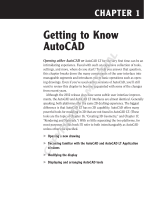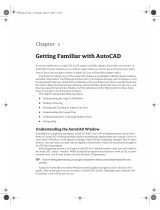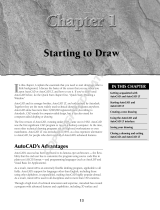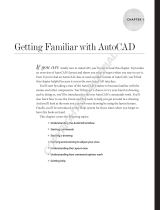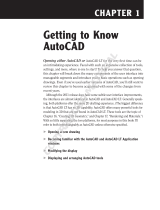Page is loading ...

AutoCAD Architecture 2009
Getting Started with AutoCAD
Architecture
March 2008

©
2008 Autodesk, Inc. All Rights Reserved. Except as otherwise permitted by Autodesk, Inc., this publication, or parts thereof, may not be
reproduced in any form, by any method, for any purpose.
Certain materials included in this publication are reprinted with the permission of the copyright holder.
Disclaimer
THIS PUBLICATION AND THE INFORMATION CONTAINED HEREIN IS MADE AVAILABLE BY AUTODESK, INC. "AS IS." AUTODESK, INC. DISCLAIMS
ALL WARRANTIES, EITHER EXPRESS OR IMPLIED, INCLUDING BUT NOT LIMITED TO ANY IMPLIED WARRANTIES OF MERCHANTABILITY OR
FITNESS FOR A PARTICULAR PURPOSE REGARDING THESE MATERIALS.
Trademarks
The following are registered trademarks or trademarks of Autodesk, Inc., in the USA and other countries: AutoCAD, Autodesk, Autodesk (logo)
ViewCube, SteeringWheels, and Revit.
All other brand names, product names or trademarks belong to their respective holders.
Third Party Software Program Credits
ACIS Copyright
©
1989-2001 Spatial Corp. Portions Copyright
©
2002 Autodesk, Inc.
Copyright
©
1997 Microsoft Corporation. All rights reserved.
International CorrectSpell
™
Spelling Correction System
©
1995 by Lernout & Hauspie Speech Products, N.V. All rights reserved.
InstallShield
™
3.0. Copyright
©
1997 InstallShield Software Corporation. All rights reserved.
PANTONE
®
and other Pantone, Inc. trademarks are the property of Pantone, Inc.
©
Pantone, Inc., 2002.
Portions Copyright
©
1991-1996 Arthur D. Applegate. All rights reserved.
Portions relating to JPEG
©
Copyright 1991-1998 Thomas G. Lane. All rights reserved. Portions of this software are based on the work of the
Independent JPEG Group.
Typefaces from the Bitstream
®
typeface library copyright 1992.
Typefaces from Payne Loving Trust
©
1996. All rights reserved.
FME Objects Engine
©
2005 SAFE Software. All rights reserved.
AutoCAD 2009 is produced under a license of data derived from DIC Color Guide
®
from Dainippon Ink and Chemicals, Inc. Copyright
©
Dainippon Ink and Chemicals, Inc. All rights reserved.
Government Use
Use, duplication, or disclosure by the U.S. Government is subject to restrictions as set forth in FAR 12.212 (Commercial Computer
Software-Restricted Rights) and DFAR 227.7202 (Rights in Technical Data and Computer Software), as applicable.

Contents
Chapter 1 Getting Started . . . . . . . . . . . . . . . . . . . . . . . . . . . . . . . . . . . . . . . . . 1
Using this Guide . . . . . . . . . . . . . . . . . . . . . . . . . . . . . . . . . . . . . . . . . . . . . . 1
Managing Your Drawings . . . . . . . . . . . . . . . . . . . . . . . . . . . . . . . . . . . . . . . . . . 4
Creating Spaces to Calculate Floor Plan Area . . . . . . . . . . . . . . . . . . . . . . . . . . . . . . . . 7
Creating Color-Filled Presentation Plans . . . . . . . . . . . . . . . . . . . . . . . . . . . . . . . . . 15
Laying Out a Floor Plan . . . . . . . . . . . . . . . . . . . . . . . . . . . . . . . . . . . . . . . . . . 16
Creating Schedules . . . . . . . . . . . . . . . . . . . . . . . . . . . . . . . . . . . . . . . . . . . . . 25
Making Floor Plan Revisions . . . . . . . . . . . . . . . . . . . . . . . . . . . . . . . . . . . . . . . . 28
Creating a Section . . . . . . . . . . . . . . . . . . . . . . . . . . . . . . . . . . . . . . . . . . . . . 31
Detailing Your Design . . . . . . . . . . . . . . . . . . . . . . . . . . . . . . . . . . . . . . . . . . . 34
iii

iv

Getting Started
Welcome to AutoCAD
®
Architecture 2009! In this short tutorial, you learn how to use the features of AutoCAD Architecture
to design and document a small office building. Working from a two-dimensional AutoCAD floor plan sketch, you quickly
create a presentation plan, a floor plan layout, door and window schedules, a section, and a detail, all within a coordinated
set of drawings.
You’ll see how a more powerful AutoCAD
®
, with features and content specialized for use by architects, can help you
increase productivity. When you design in AutoCAD Architecture, you use objects that represent real-world components,
such as walls, doors, and windows. These objects contain information that allows them to function like the real-world
components that they represent and to relate intelligently to each other.
In addition to your main design tasks, many background tasks, such as layering and scaling, are automated as you design
and document your drawing set. A simple tool, called the Project Navigator, allows you to easily work with all the drawings
in a project, eliminating the need to set up and maintain a complex file structure.
Using this Guide
To complete the tutorial in this guide, you must have AutoCAD Architecture installed on your system. As
you progress through the tutorial exercises, you access tutorial drawings and other content from the default
installation directories.
If you cannot locate a file in the location that this guide suggests, it may be installed in a different location.
Contact your CAD Manager for more information.
1
1

Imperial and Metric Convention
The exercises in this guide contain both imperial and metric values. This means that when you see an
imperial value, a metric value is displayed in square brackets next to it.
For example: Add a 6' X 6' [1800 mm X 1800 mm] window centered in the top wall of the stairway.
All audiences using imperial measurements should use the imperial values only. All audiences using metric
measurements should use the metric values in brackets only. Note that the imperial and metric values are
not direct conversions, but appropriate values for completing either the imperial or metric project.
Opening the Project
In this exercise, you start AutoCAD Architecture, learn how to access AutoCAD Architecture learning resources,
and open the project that contains the drawings you use to complete the tutorial. In AutoCAD Architecture,
you use projects to store and manage all the drawings that you create to design and document your projects.
1 Start AutoCAD Architecture.
2 If this is the first time you have opened AutoCAD Architecture, a Welcome screen displays.
3 On the right side of the screen, under Essential Task Movies, click each title to view 2-minute
movies that present the concepts you need to know to perform common design and
documentation tasks in AutoCAD Architecture.
The movies correspond to the exercises in this guide, so you can benefit from both conceptual
and hands-on learning.
4 On the left side of the screen, explore the additional learning resources available to you:
■ Click User Interface Overview to interactively explore the AutoCAD Architecture user interface.
(This overview is strongly recommended for new users.)
■ Click Learning Resources to access customized learning paths for different types of users,
including new and upgrading users.
■ Click New Features Workshop to view short animations that describe the new features in
this and recent releases of AutoCAD Architecture.
■ Click AutoCAD to AutoCAD Architecture Task Comparisons to learn how to accomplish
typical design and documentation tasks using the features and workflow of AutoCAD
Architecture.
5 If you do not want the Welcome screen to display each time you start AutoCAD Architecture,
clear Show this dialog at startup.
6 After you view the movies and other learning resources, close the Welcome screen.
2 | Chapter 1 Getting Started

7 A Workspaces toolbar, located under the drop-down menus at the top left of the screen, lets
you choose the workspace that you use to begin your project.
Each AutoCAD Architecture workspace includes the specific user interface components that you
use in the appropriate phase of your project. For example, the Design workspace contains all
the basic tools that you need to create building components in your design drawings. The Design
workspace is selected by default.
8 Display tooltips:
Several types of tooltips provide pop-up information for interactions with toolbars, object snaps,
and drafting operations. You can view tooltips in toolbars, the menu browser, and dialogs.
Initially, a basic tooltip displays.
If you continue to hover the cursor, the tooltip expands to display any additional information.
9 Turn the display of tooltips on or off:
■ Click Format menu ➤ Options.
■ Click the Display tab.
Opening the Project | 3

■ Under Window Elements, select or clear Show ToolTips.
■ If you want to change the time interval between displaying the basic tooltip text and the
extended information, select a different delay value. If you want to turn off the extended
tooltip information completely, clear Show extended ToolTips.
■ Click OK.
10 Open the tutorial project:
■ On the Navigation toolbar, click (Project Browser).
You use the Project Browser to create, copy, and switch between projects.
■ In the left pane, click , and scroll up to view the current file path and folder.
By default, the path and folder is C:\My Documents\Autodesk\My Projects. This is the
location of the project file that you open and use for this tutorial.
■ In the left pane of the Project Browser, double-click the project, Getting_Started_I
[Getting_Started_M].
The project displays in bold type to indicate it is the current project. The right pane of the
Project Browser displays the project bulletin board, which can be used to communicate
information about the current project.
■ Click Close.
Two important workspace features display: a Getting_Started project tool palette and the
Project Navigator.
The Getting_Started project tool palette contains all the AutoCAD Architecture tools that
you need to complete the exercises in this guide. Tools are objects that you use to draw in
AutoCAD Architecture, and they are arranged on tabbed palettes. The tool represents the
real-world object that you want to add to your drawing.
Using the Project Navigator, you create, access, and organize drawings in the current project
within the software environment.
Managing Your Drawings
In this exercise, you learn how AutoCAD Architecture project drawings are organized and managed. The
Drawing Management feature in AutoCAD Architecture lets you distribute your building geometry amongst
a number of drawing files and manage them with the Project Navigator. In the past, you may have used
Microsoft
®
Windows
®
Explorer and the AutoCAD Xref Manager.
4 | Chapter 1 Getting Started

To store and manage drawings with this feature, you first create a project. In the project, you create the basic
levels (floors) and divisions (wings) of the building model to create a matrix of locations where you can
assign the drawings that contain the geometry of your model.
Using enhanced AutoCAD Xref technology, drawings that contain the building geometry can then be
referenced together, and views of the building can be created and referenced onto plotting sheets. Depending
on whether the drawings contain building geometry, assemble views of the building, or contain plotting
sheets, they are classified within projects as constructs, elements, views, and sheets.
1 View the tabs on the Project Navigator.
The 4 tabs on the side of the Project Navigator let you create, access, and organize the drawings
in the current project.
2 Click the Project tab.
The Project tab reports information that has already been added to the project: the project name
and number, and the levels and divisions that it contains. Levels are the floors of the building,
and divisions are wings or segments of the building. As you create design drawings in this
tutorial, you will assign them a location on a building level. This Getting Started Project contains
5 levels and a single default division.
3 Click the Constructs tab.
This tab lists the drawings that create the geometry of your building. These drawings are classified
as constructs or elements.
Constructs are the main building blocks of your design. They define unique portions of the
building, and are assigned to a location (level and division) within it.
Managing Your Drawings | 5

Although this Getting Started project is unfinished, a few constructs reside in the project: 4 floor
slabs, an elevator shaft, and an 05 floor. You will create constructs for floors 1-4 of the building.
In contrast, elements contain collections of geometry that can be used repeatedly in different
design drawings, such as a drawing of a service core that would be referenced onto multiple
floors of a building. In the AutoCAD Architecture project workflow, elements are referenced
into constructs.
In this project, 2 typical restroom elements are provided. You will place these layouts on floors
1-4 of the building by referencing them into each floor construct.
4 Click the Views tab.
The Views tab lists view drawings in which constructs and elements are referenced to provide
specific views of a building. Views allow you to tell AutoCAD Architecture in architectural terms
what types of drawings you want to assemble, such as first floor plans, second floor framing
plans, or building sections. Views may contain any number of constructs, which in turn, may
reference elements. After you create views, you can organize them on sheets.
No view drawings have been created in the Getting Started project.
6 | Chapter 1 Getting Started

5 Click the Sheets tab.
The Sheets tab lists a set of project drawing sheets that you can plot or electronically publish.
Sheet drawings contain paperspace layouts that comprise the sheet layout. You reference model
space views from view drawings onto sheets to create sheet views.
If you are familiar with the AutoCAD Sheet Set Manager, the Sheets tab should also look familiar.
Since sheets contain views (which reference constructs) and elements, any changes to the design
in the constructs or elements can be easily updated in the views and sheets, by reloading any
externally referenced drawings.
Now that you have an overview of how your drawings are organized and managed in AutoCAD
Architecture, proceed to the next exercise to start designing.
Creating Spaces to Calculate Floor Plan Area
In this exercise, you use the automated space planning tools in AutoCAD Architecture to calculate area on
a preliminary floor plan. You use the linework in a 2D floor plan sketch (created in AutoCAD) to quickly
generate 2D spaces complete with tags that report each room area. After you create the spaces, you place a
Creating Spaces to Calculate Floor Plan Area | 7

room schedule that automatically reads the area information from the space tags, and reports it in the
schedule table.
When the schedule is complete, you use the editing grips available on AutoCAD Architecture objects to
change the dimensions of a space on the floor plan. The space tag automatically reports the new room area,
and with the click of a button, you update the schedule to include the new area.
1 Open an AutoCAD drawing that contains the 2D floor plan sketch:
■ Click File menu ➤ Open.
■ Navigate to C:\My Documents\Autodesk\My Projects\Getting_Started_I [Getting_Started_M].
■ Select 01 Spaces Layout.dwg, and click Open.
The sketch, complete with delineated rooms for the space plan layout, displays. Although the
sketch is located in the project, it is not a project drawing (construct, element, view, or sheet).
You must save the sketch drawing to the project as a construct before you create the space plan.
2 Save the sketch to the project as a construct:
■ With 01 Spaces Layout open, on the Project Navigator, click the Constructs tab.
■ Right-click the Constructs folder, and click Save Current Dwg As Construct.
■ On the Add Construct worksheet, click the Name field, and enter 01 Spaces.
■ Under Assignments, for Level 1, select Division 1.
8 | Chapter 1 Getting Started

This setting assigns the 01 Spaces construct to the first floor (level) of the building, in division
1 of the building. By default, each project has a single division.
■ Click OK.
Notice the open drawing has been renamed 01 Spaces, and displays in the Constructs folder
on the Project Navigator.
Next, access a space tool, and set the space properties so that the spaces you create are 2D and
are tagged as they are created. The tools in AutoCAD Architecture streamline object creation by
allowing you to specify common options before you create the object.
3 On the Getting_Started tool palette, click General Space Tool.
If the tool is not visible, use the scroll bar on the side of the palette to locate it.
4 Specify the space properties:
■ On the Properties palette, under General, for Style, verify that Standard is selected.
■ For Tag, select Aec8_Space_Tag [M_Aec8_Space_Tag].
■ For Create type, select Generate.
■ For Associative, select No.
■ Under Component Dimensions, for Geometry Type, select 2D.
5 Without clicking inside a room, move the cursor into each room on the plan.
As you move the cursor into a room, the space object automatically detects the linework room
boundary. The boundary of the space that you can generate from the room linework displays
in red.
6 Click in the large room on the bottom of the plan.
A tagged space is created.
Creating Spaces to Calculate Floor Plan Area | 9

7 Autogenerate the remaining spaces on the plan:
■ Right-click in the drawing, and click Generate all.
Tagged spaces are created in the remaining rooms.
■ Press ESC to end the Space command.
8 Reposition one of the tags in the upper left space:
■ Zoom to the 5 spaces in the upper left corner of the floor plan.
■ If necessary, on the application status bar, click (Object Snap) to turn it off.
■ Select the tag that overlaps the 2 spaces on the lower right of the zoomed area.
A cyan Location grip displays on the tag.
10 | Chapter 1 Getting Started

■ Select and move the Location grip to reposition the tag centrally on the space.
■ Press ESC to end the command.
9 If necessary, reposition the tags in the other spaces on the plan.
The space tags on the floor plan report that all the rooms are the same type of space. Next, learn
how to use the different space tools to create space objects for other room types on the plan.
10 Redefine the spaces on the plan:
■ On the Getting_Started tool palette, right-click the Corridor tool, and click Apply Tool
Properties to ➤ Space.
■ Select the 4 corridors on the floor plan, as shown.
Creating Spaces to Calculate Floor Plan Area | 11

TIP Make sure you select the space and not the tag.
■ Press ENTER, and press ESC.
The space tag now identifies each selected space as a corridor, and the space displays with a
colored fill.
■ Use the other space tools on the Getting_Started tool palette that correspond to the names
in the plan shown to redefine the remaining spaces on the plan. When you finish, all spaces
will display with colored fills.
12 | Chapter 1 Getting Started

IMPORTANT Press ESC after creating each space type to end the previous space command.
11 Create a preliminary room schedule that reports the name and area of each room:
■ On the Getting_Started tool palette, click the Room Area Schedule tool.
■ On the command line, enter all, and press ENTER twice.
■ Move the cursor to the left of the floor plan until the bottom of the schedule table aligns
with the bottom conference room wall, and click to place the upper left corner of the schedule.
■ Press ENTER to place the bottom right corner of the schedule.
The schedule uses the space tags to read the information, called property set data, that is
attached to the spaces, and reports it in the schedule table.
Creating Spaces to Calculate Floor Plan Area | 13

12 Modify the dimensions of a space on the plan, and observe changes in the schedule:
■ Select the large conference room on the right side of the drawing to display editing grips.
■ Click the lower edge grip, drag the edge down, and click to resize the room.
The exact dimensions are not important, but ensure that the conference room is noticeably
larger. Notice that the space tag reports the new area and dimensions after you resize the
room.
■ Press ESC to end the command.
The room schedule updates automatically as the conference room size has changed.
13 View the schedule:
■ Zoom to the schedule, and view the new area that is reported for Conference_Room.
14 On the Standard toolbar, click (Undo) until the space is restored to its original dimensions.
15 On the Standard toolbar, click (Save).
14 | Chapter 1 Getting Started

Creating Color-Filled Presentation Plans
In this exercise, you use a display theme to rapidly create a graphic report of the spaces. When you create
the report, the space data is read, and the spaces fill with color depending on the current report criteria. A
legend that you place near the color-filled floor plan represents the theme and indicates the colors used in
the plan.
1 On the Project Navigator, click the Views tab.
2 Create a view that references the 01 Spaces construct:
■ Right-click the Views folder, and click New View Dwg ➤ General.
■ In the Add General View dialog, for Name, enter 01 Space Plan, and click Next.
■ For Level 1, select Division 1, and click Next.
■ Clear all constructs except 01 Spaces.
■ Select Open in drawing editor, and click Finish.
■ Zoom Extents to see the 01 Space Plan in the drawing area.
3 Create a display theme that identifies the spaces by size:
■ On the Getting_Started tool palette, click the Theme - Space Size tool.
■ Specify a point to the left of the room schedule to place the upper left corner of the legend.
■ Press ENTER to place the legend.
Creating Color-Filled Presentation Plans | 15

4 On the Standard toolbar, click (Save), and leave 01 Space Plan open.
Laying Out a Floor Plan
In this exercise, you develop a floor plan from a 2D linework sketch created in AutoCAD. You open the
drawing in AutoCAD Architecture, and add it to the Getting Started project as the 01 Floor plan construct.
Using the design tools included in AutoCAD Architecture, you quickly and easily convert the linework in
the sketch to interior and exterior walls, and then add doors, windows, stairs, and spaces. Because you are
working with design objects that function like their real-world counterparts, you have complete control
over your design as you define object dimensions and placement.
1 Open the AutoCAD drawing that contains a floor plan sketch:
■ On the Quick Access toolbar, click (Open).
■ Navigate to C:\My Documents\Autodesk\My Projects\Getting_Started_I [Getting_Started_M].
■ Select 01 Walls Layout.dwg, and click Open.
A sketch similar to the one that you used to create the space plan displays. To use it to create
a floor plan, you need to assign it to the project as a logical piece of the building, the first
floor construct.
2 Save the sketch as a construct:
■ On the Project Navigator, click the Constructs tab.
■ Right-click the Constructs folder, and click Save Current Dwg As Construct.
■ On the Add Construct worksheet, click the Name field, and enter 01 Floor.
■ Click in the Description field, enter Entry level floor, and click OK.
■ On the Add Construct worksheet, under Assignments, for Level 1, select Division 1, and click
OK.
Notice the open drawing has been renamed 01 Floor, and displays in the Constructs folder
on the Project Navigator.
3 Convert the exterior linework to exterior walls:
■ On the Getting_Started tool palette, right-click the Exterior Wall tool, and click Apply Tool
Properties to ➤ Linework.
16 | Chapter 1 Getting Started
/
